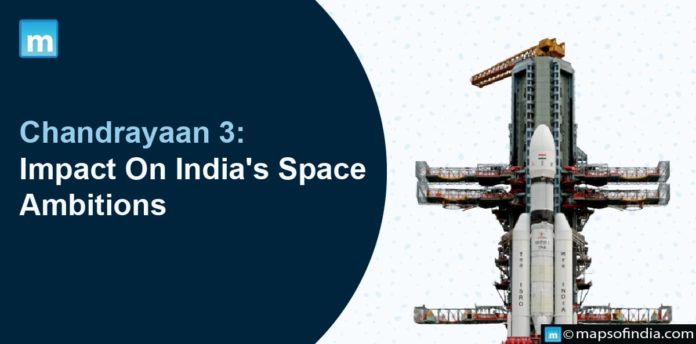India made history on August 23 as it became the fourth country to land on the moon’s surface, after Russia, the United States, and China. The Chandrayaan 3 mission solidified the country’s status as a significant player in space exploration as it became the first country to land on the moon’s south pole. With the successful landing of Chandrayaan 3, PM Modi said, “Every Indian is celebrating today. Every home is celebrating. I am also connected to the people of my country at this proud moment. It is the dawn of a new era.”
Exploring Chandrayaan 3
Chandrayaan 3 is India’s third lunar mission. Its attempt is to soft-land a lander and a rover on the moon’s south pole. The lander was named Vikram after the father of the Indian Space Programme, Vikram Sarabhai, and the rover was named Pragyaan, a Sanskrit word that means wisdom.
In 2008, India launched its Chandrayaan 1 mission, and it found something that shook the world – Water on the moon. The mission brought the first strong evidence that water is available on the moon’s south pole. To research this further, India launched Chandrayaan 2, a rover mission, in 2019, which unfortunately was unsuccessful. ISRO then launched Chandrayaan 3 to fulfill the same objectives as Chandrayaan 2. After accumulating all the problems with the second lunar mission, the organization made a lot of modifications to the current one.
Science and Technology
Let’s talk about what Chandrayaan 3 comprises. These components play an equally important part in the success of this mission.
The Lander
The Chandrayaan 3 lander Vikram is responsible for soft-landing the rover on the Moon’s South Pole. It was able to make a successful landing on the surface due to the number of systems it is equipped with, including a radar altimeter, a guidance system, and a braking system. The lander also has several scientific instruments, including a camera, a spectrometer, and a magnetometer, which will be used to study the moon’s surface and atmosphere.
The Rover
The Chandrayaan 3 rover Pragyaan is a six-wheeled vehicle designed to explore the Moon’s South Pole for up to 14 days. Its main objectives are to study the atmosphere and surface of the moon and look for any water that is thought to exist there. It is equipped with several tools to successfully achieve its objectives, including a camera, a spectrometer, and a drill.
The Orbiter
One should not underestimate the power of an Orbiter. Chandrayaan 2’s Orbiter contributed to the success of this mission as it took high-quality images of the moon that helped in the landing. The Chandrayaan 3 Orbiter will orbit the moon for a year and is equipped with many scientific instruments. Its main objectives are to study the moon’s surface, atmosphere, and gravity field and communicate with the Lander and Rover.
A Milestone for India
The Chandrayaan-3 mission symbolises India’s growing technological prowess and its commitment to space exploration. The mission helps India and the entire world learn about the moon’s south pole, an area that is not well explored. However, this is just the beginning of India’s moon exploration. In 2025, ISRO plans to send Indian Astronauts to the moon with their next mission, Gaganyaan. The eyes of the world are on India as it takes another giant leap forward in its quest to explore the moon.





